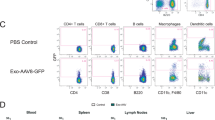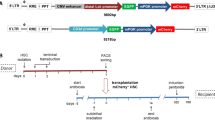Abstract
Gene electrotranfer is an attractive physical method to deliver genes to target tissues. The aim of this study was to evaluate in vivo gene electrotransfer into spleen, one of the most important lymphoid organ, in order to create a new tool to modulate the immuno-inflammatory system. C57Bl/6 mice were submitted either to intramuscular electrotransfer (IME) as a reference method or to intrasplenic (ISE) gene electrotransfer. In the naked injected plasmids, the CMV promoter controlled the expression of luciferase, secreted alkaline phosphatase, EGFP, or IFNγ. The ISE optimal electrotransfer conditions were first determined and ISE was found to be an efficient gene transfer method, which can be used to express secreted or intracellular proteins transiently. Although transfected cells were still present in the spleen 30 days after ISE, transfected spleen cells could recirculate since they were detected in extrasplenic locations. Using a T-lymphocyte-specific promoter controlling the expression of EGFP, splenic T cells could be targeted. Finally, it appeared that ISE procedure does not impair by itself the immune response and does not result in a significant production of antibodies directed to the transgenic proteins in C57Bl/6 mice. This strategy constitutes a new method to manipulate the immune response that can be used in various experimental designs.
This is a preview of subscription content, access via your institution
Access options
Subscribe to this journal
Receive 12 print issues and online access
$259.00 per year
only $21.58 per issue
Buy this article
- Purchase on Springer Link
- Instant access to full article PDF
Prices may be subject to local taxes which are calculated during checkout









Similar content being viewed by others
References
Neumann E, Schaefer-Ridder M, Wang Y, Hofschneider PH . Gene transfer into mouse lyoma cells by electroporation in high electric fields. EMBO J 1982; 1: 841–845.
Klenchin VA et al. Electrically induced DNA uptake by cells is a fast process involving DNA electrophoresis. Biophys J 1991; 60: 804–811.
Zheng QA, Chang DC . High-efficiency gene transfection by in situ electroporation of cultured cells. Biochim Biophys Acta 1991; 1088: 104–110.
Sukharev SI et al. Electroporation and electrophoretic DNA transfer into cells. The effect of DNA interaction with electropores. Biophys J 1992; 63: 1320–1327.
Tripathy SK et al. Stable delivery of physiologic levels of recombinant erythropoietin to the systemic circulation by intramuscular injection of replication- defective adenovirus. Proc Natl Acad Sci USA 1994; 91: 11557–11561.
Tsurumi Y et al. Direct intramuscular gene transfer of naked DNA encoding vascular endothelial growth factor augments collateral development and tissue perfusion. Circulation 1996; 94: 3281–3290.
Naffakh N et al. Long-term secretion of therapeutic proteins from genetically modified skeletal muscles. Hum Gene Ther 1996; 7: 11–21.
Miller G et al. Expression of factor VII by muscle cells in vitro and in vivo following direct gene transfer: modelling gene therapy for haemophilia. Gene Ther 1995; 2: 736–742.
Rizzuto G et al. Efficient and regulated erythropoietin production by naked DNA injection and muscle electroporation. Proc Natl Acad Sci USA 1999; 96: 6417–6422.
Piccirillo CA, Prud'homme GJ . Prevention of experimental allergic encephalomyelitis by intramuscular gene transfer with cytokine-encoding plasmid vectors. Hum Gene Ther 1999; 10: 1915–1922.
Schratzberger P et al. Reversal of experimental diabetic neuropathy by VEGF gene transfer. J Clin Invest 2001; 107: 1083–1092.
Montgomery DL, Ulmer JB, Donnelly JJ, Liu MA . DNA vaccines. Pharmacol Ther 1997; 74: 195–205.
Titomirov AV, Sukharev S, Kistanova E . In vivo electroporation and stable transformation of skin cells of newborn mice by plasmid DNA. Biochim Biophys Acta 1991; 1088: 131–134.
Heller R et al. In vivo gene electroinjection and expression in rat liver. FEBS Lett 1996; 389: 225–228.
Suzuki T et al. Direct gene transfer into rat liver cells by in vivo electroporation. FEBS Lett 1998; 425: 436–440.
Rols MP et al. In vivo electrically mediated protein and gene transfer in murine melanoma. Nat Biotechnol 1998; 16: 168–171.
Aihara H, Miyazaki J . Gene transfer into muscle by electroporation in vivo. Nat Biotechnol 1998; 16: 867–870.
Mir LM et al. Long-term, high level in vivo gene expression after electric pulse-mediated gene transfer into skeletal muscle. CR Acad Sci HI 1998; 321: 893–899.
Mir LM et al. High-efficiency gene transfer into skeletal muscle mediated by electric pulses. Proc Natl Acad Sci USA 1999; 96: 4262–4267.
Bettan M, Darteil R, Scherman D . Secreted human placental alkaline phosphatase as a reporter gene for in vivo gene transfer. Anal Biochem 1999; 271: 187–189.
Kreiss P, Bettan M, Crouzet J, Scherman D . Erythropoietin secretion and physiological effect in mouse after intramuscular plasmid DNA electrotransfer. J Gene Med 1999; 1: 245–250.
Bettan M et al. High-level protein secretion into blood circulation after electric pulse-mediated gene transfer into skeletal muscle. Mol Ther 2000; 2: 204–210.
Payen E et al. Improvement of mouse beta-thalassemia by electrotransfer of erythropoietin cDNA. Exp Hematol 2001; 29: 295–300.
Contag CH et al. Photonic detection of bacterial pathogens in living hosts. Mol Microbiol 1995; 18: 593–603.
Contag CH et al. Visualizing gene expression in living mammals using a bioluminescent reporter. Photochem Photobiol 1997; 66: 523–531.
Contag PR, Olomu IN, Stevenson DK, Contag CH . Bioluminescent indicators in living mammals. Nat Med 1998; 4: 245–247.
Mennuni C et al. Hyaluronidase increases electrogene transfer efficiency in skeletal muscle. Hum Gene Ther 2002; 13: 355–365.
Salmon P et al. Characterization of an intronless CD4 minigene expressed in mature CD4 and CDS T cells, but not expressed in immature thymocytes. J Immunol 1996; 156: 1873–1879.
Velikovsky CA et al. Single-shot plasmid DNA intrasplenic immunization for the production of monoclonal antibodies. Persistent expression of DNA. J Immunol Methods 2000; 244: 1–7.
Soubrier F et al. pCOR: a new design of plasmid vectors for nonviral gene therapy. Gene Ther 1999; 6: 1482–1488.
Nicoletti A et al. Immunoglobulin treatment reduces atherosclerosis in apo E knockout mice. J Clin Invest. 1998; 102: 910–918.
Acknowledgements
This work was supported by INSERM and by a grant from the Association Claude Bernard. B Poirier was the recipient of a fellowship from GRRC and E Tupin was the recipient of a fellowship from the ARCOL.
Author information
Authors and Affiliations
Rights and permissions
About this article
Cite this article
Tupin, E., Poirier, B., Bureau, M. et al. Non-viral gene transfer of murine spleen cells achieved by in vivo electroporation. Gene Ther 10, 569–579 (2003). https://doi.org/10.1038/sj.gt.3301914
Received:
Accepted:
Published:
Issue Date:
DOI: https://doi.org/10.1038/sj.gt.3301914
Keywords
This article is cited by
-
Biological and immunotoxicity evaluation of antimicrobial peptide-loaded coatings using a layer-by-layer process on titanium
Scientific Reports (2015)
-
Gene Transfer: How Can the Biological Barriers Be Overcome?
The Journal of Membrane Biology (2010)
-
Gene electrotransfer: from biophysical mechanisms to in vivo applications
Biophysical Reviews (2009)
-
Intravital imaging of fluorescent markers and FRET probes by DNA tattooing
BMC Biotechnology (2007)
-
Nanosized bioceramic particles could function as efficient gene delivery vehicles with target specificity for the spleen
Gene Therapy (2007)



